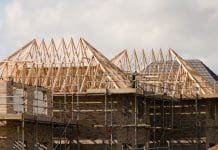New research has revealed that although new homes in London saw growth during Q2 2016 when compared to Q1 this progress could be short-lived
During the second quarter of 2016 the number of new home approvals in London rose to 6,130, despite Brexit voting concerns. However, experts are warning progress could be in doubt.
The research, which was carried out by Stirling Ackroyd, revealed new home approval rates recovered during Q2 to 76 per cent. Comparatively, this figure had stood at just 61 per cent in the previous quarter.
The London New Homes Monitor also showed that out of a possible 8,280 new homes put forward for approval only 76 per cent (6,310) were given permission. This represented a 46 per cent quarter-on-quarter improvement since Q1, when only 4,300 new homes were given approval.
Andrew Bridges, managing director of Stirling Ackroyd, said: “We keep on hearing negativity when it comes to housing in London: not enough space, not enough money, too much nimbyism. In fact, there’s plenty of room and sufficient progress isn’t being made on a yearly basis.
“Our research suggests space for up to 570,000 across the next ten years. Sadiq Khan may be keen to protect Green Belt sites but good development is possible there too, and we need to think the politically unthinkable to solve the housing crisis.”
He added: “There’s a clear and difficult road ahead to solve London’s housing deficit. A big challenge is how to ensure the government’s promise of one million new homes and Sadiq Khan’s promises of over 50,000 in London, are delivered now Brexit is a reality.
“A more efficient planning system is the place to start. Crucially, planning reforms are still on the government agenda for now – and they need to stay there.
“Overall, more resources and time need to be committed to achieve the number of new homes London needs. Having a new home can transform lives and London has always been an aspirational city.”
The London approval average of 76 per cent was only surpassed by 13 out of 33 boroughs, but was an improvement on Q1 which saw this rate drop to 61 per cent.
According to the data Westminster approved 1,720, making the borough the most proactive. It allowed 99 per cent of new home applications to pass. Merton granted permission for 88 per cent of new properties, while Tower Hamlets and Havering both hit 87 per cent.
Bridges said: “The East of London appears the most reliable area when it comes to tackling London’s housing crisis.
“Planning is more lenient, there’s less resistance to new developments and the area keeps growing in vibrancy and significance to the London economy.
“East London’s impressive tech sector is just a starting point – and success will continue to ripple around the surrounding locales. More and more, people are wanting to live in Shoreditch, Dalston and Hackney Wick – and this enthusiasm is driving developers to the area.
“It’s great to see overall progress but certain boroughs are slowing things down – Newham has seen a rigid approach to planning in Q2, which will need to be reversed if a consistent approach is to be enacted across London.
“Again, the ugly inner/outer divide has reared its head – with outer London remaining defiant against new homes and new developments.
“Unfortunately for London, consistency is key to solving the planning equation. If planning departments are to embrace a new strategy, some tough love from central government might be needed. And Gavin Barwell may be the man to do it – only time will tell.”
On the other end of the scale Bromley and Islington were found to have performed poorly, with the former approving just 23 per cent of planning approvals and the latter only 36 per cent. Newham came bottom of the table, rejecting 92 per cent of new homes in Q2.
“London has had a tough time lately, as Brexit injected a dose of uncertainty into the property market. In spite of this, the number of new home approvals improved in the run up to the result,” Bridges said.
“There may still be an impact to come but for now, this pick-up is a sign that London’s property market is resilient. It’s a new game of unknowns – and London could emerge a winner.
“Westminster is soaring ahead in terms of approvals and applications, but these are unlikely to be affordable for the typical Londoner. Many in the Capital are left feeling let down as affordability drives them further away from a home of their own.
“A new Housing Minister means new rules though – and London could be set for a shake-up. The revival of a Minister for London could bring some reassurance to developers, and buyers, who are hoping for a pro-building government under Theresa May. Realistically, however, it’s more likely to be business as usual.”
Figures also revealed that the approval rates in Q2 2016 trailed behind those seen in Q2 2015 on a quarter-on-quarter basis. The latter saw 6,083 out of a possible 10,662 granted permission, while Q2 2016 saw just 6,311 allowed.












![[VIDEO]Government launches new online appeal service for local planning authorities Group of young coworkers using computers in their group office, representing the new online appeals service](https://www.pbctoday.co.uk/news/wp-content/uploads/2025/12/iStock-2191280160-218x150.jpg)


